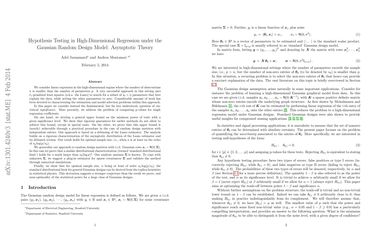Hypothesis Testing in High-Dimensional Regression under the Gaussian Random Design Model: Asymptotic Theory
We consider linear regression in the high-dimensional regime where the number of observations $n$ is smaller than the number of parameters $p$. A very successful approach in this setting uses $\ell_1$-penalized least squares (a.k.a. the Lasso) to search for a subset of $s_0< n$ parameters that best explain the data, while setting the other parameters to zero. Considerable amount of work has been devoted to characterizing the estimation and model selection problems within this approach. In this paper we consider instead the fundamental, but far less understood, question of \emph{statistical significance}. More precisely, we address the problem of computing p-values for single regression coefficients. On one hand, we develop a general upper bound on the minimax power of tests with a given significance level. On the other, we prove that this upper bound is (nearly) achievable through a practical procedure in the case of random design matrices with independent entries. Our approach is based on a debiasing of the Lasso estimator. The analysis builds on a rigorous characterization of the asymptotic distribution of the Lasso estimator and its debiased version. Our result holds for optimal sample size, i.e., when $n$ is at least on the order of $s_0 \log(p/s_0)$. We generalize our approach to random design matrices with i.i.d. Gaussian rows $x_i\sim N(0,\Sigma)$. In this case we prove that a similar distributional characterization (termed `standard distributional limit') holds for $n$ much larger than $s_0(\log p)^2$. Finally, we show that for optimal sample size, $n$ being at least of order $s_0 \log(p/s_0)$, the standard distributional limit for general Gaussian designs can be derived from the replica heuristics in statistical physics.
PDF Abstract

